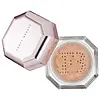What's inside
What's inside
 Key Ingredients
Key Ingredients

 Benefits
Benefits

 Concerns
Concerns

 Ingredients Side-by-side
Ingredients Side-by-side

Silica
AbrasiveCaprylic/Capric Triglyceride
MaskingSerica
HumectantHydrolyzed Silk
HumectantSericin
Skin ConditioningCamellia Sinensis Leaf
PerfumingNacre Powder
AbrasiveCaesalpinia Spinosa Fruit Extract
Skin ProtectingKappaphycus Alvarezii Extract
Skin ConditioningTitanium Dioxide
Cosmetic ColorantMagnesium Myristate
Propanediol
SolventMethicone
EmollientHydrogen Dimethicone
Stearic Acid
CleansingCerium Oxide
Aluminum Hydroxide
EmollientEthylhexylglycerin
Skin ConditioningTocopherol
AntioxidantWater
Skin ConditioningPhenoxyethanol
PreservativeMica
Cosmetic ColorantZinc Oxide
Cosmetic ColorantCI 77891
Cosmetic ColorantSynthetic Fluorphlogopite
Iron Oxides
Silica, Caprylic/Capric Triglyceride, Serica, Hydrolyzed Silk, Sericin, Camellia Sinensis Leaf, Nacre Powder, Caesalpinia Spinosa Fruit Extract, Kappaphycus Alvarezii Extract, Titanium Dioxide, Magnesium Myristate, Propanediol, Methicone, Hydrogen Dimethicone, Stearic Acid, Cerium Oxide, Aluminum Hydroxide, Ethylhexylglycerin, Tocopherol, Water, Phenoxyethanol, Mica, Zinc Oxide, CI 77891, Synthetic Fluorphlogopite, Iron Oxides
 Reviews
Reviews

Ingredients Explained
These ingredients are found in both products.
Ingredients higher up in an ingredient list are typically present in a larger amount.
Ci 77891 is a white pigment from Titanium dioxide. It is naturally found in minerals such as rutile and ilmenite.
It's main function is to add a white color to cosmetics. It can also be mixed with other colors to create different shades.
Ci 77891 is commonly found in sunscreens due to its ability to block UV rays.
Learn more about CI 77891Ethylhexylglycerin (we can't pronounce this either) is commonly used as a preservative and skin softener. It is derived from glyceryl.
You might see Ethylhexylglycerin often paired with other preservatives such as phenoxyethanol. Ethylhexylglycerin has been found to increase the effectiveness of these other preservatives.
Silica, also known as silicon dioxide, is a naturally occurring mineral. It is used as a fine, spherical, and porous powder in cosmetics.
Though it has exfoliant properties, the function of silica varies depending on the product.
The unique structure of silica enhances the spreadability and adds smoothness, making it a great texture enhancer.
It is also used as an active carrier, emulsifier, and mattifier due to its ability to absorb excess oil.
In some products, tiny microneedles called spicules are made from silica or hydrolyzed sponge. When you rub them in, they lightly polish away dead skin layers and enhance the penetration of active ingredients.
Learn more about SilicaThis ingredient is a combination of red, black, and yellow iron oxide pigments. This combination of colors is usually found in foundation, because it results in a "skin" color.